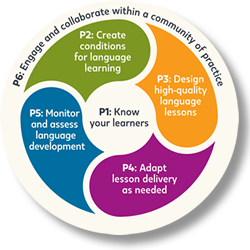From the President: Utilizing The 6 Principles—for Exemplary Leadership
by Gabriela Kleckova
TESOL
International Association, based on a large body of research, has identified a
set of universal principles to guide English language teaching. As you may
already know, The 6 Principles provide a basis for effective language
instruction that leads to successful language learning outcomes. You can
explore them at www.the6principles.org, but here is just a short reminder:
-
 Principle 1. Know Your
Learners
Principle 1. Know Your
Learners
-
Principle 2. Create
Conditions for Language Learning
-
Principle 3. Design High-Quality Lessons for Language Development
-
Principle 4. Adapt Lesson
Delivery as Needed
-
Principle 5. Monitor and Assess Student Language Development
-
Principle 6. Engage and Collaborate within a Community of Practice
In this column, I have
decided to experiment with these brilliant, simple, yet powerful principles for
language teaching to talk about leadership and share what I have learned about
it in my diverse formal and informal leadership roles inside and outside TESOL.
Principle 1. Know Those You Lead
I believe it
is important to know those we lead: expectations, experiences, commitments,
personal and professional skills, strengths, contexts, cultures, technology
skills, and so forth all shape people’s performance. If we have basic
information about these, we are more likely to lead more effectively and engage
everyone. Very often, we go directly to business with a group of people we
lead, but it has been my experience that taking time to talk to people, learn
about them, and seek understanding of where they come from and what matters to
them have paid off in getting the actual business done later—and better. I
understand that the level of this understanding might be influenced by our
cultural contexts and personalities, but like we all understand that knowing
who we teach makes our teaching better, knowing who we lead makes our leading
better.
Principle 2. Create Conditions for Outcomes
It is the
leader’s responsibility to create a culture that will allow everyone to perform
to their best and feel comfortable and respected. Leaders need to consider
clear expectations, roles, and goals; effective communication and processes;
autonomy; trust; responsibility; and partnership and collaboration. Of course,
respect of the context and acknowledgment of local needs, values, and
established practices come into play as well. Like in a classroom where we
aspire to establish conditions to make learners feel comfortable, safe, and
motivated to promote language learning, we should aspire to create a working
environment that will positively impact the performance of those we lead. The
actual culture of such an environment is not universal; though many topics may
fall under basic human needs, the rest is, as already pointed out, based on the
local culture.
Principle 3. Design
High-Quality Activities
Planning
should be guiding our leadership actions. We should plan for meaningful
initiatives, activities, and tasks that move issues forward. This primarily
involves having clear and shared goals and outcomes for the entity we lead and
planning for strategies to address these. It also involves thinking about time
and efficiency and figuring out how to get the best possible outcomes in the
particular context and available time:
In teaching,
our lessons are driven by learning objectives; in leadership, our activities
are driven by short-term and long-term goals.
Principle 4. Adapt Your
Style as Needed
 I also
believe that it is a must to be flexible in how we lead. We should continually
assess our style and check whether any adaptation is needed to fill in any gaps
of support and guidance. We should be observing and reflecting on people’s
performance, engagement, opinions, and feelings. We should be asking questions
to learn about any struggles people may have as we work with them toward a
common goal.
I also
believe that it is a must to be flexible in how we lead. We should continually
assess our style and check whether any adaptation is needed to fill in any gaps
of support and guidance. We should be observing and reflecting on people’s
performance, engagement, opinions, and feelings. We should be asking questions
to learn about any struggles people may have as we work with them toward a
common goal.
For
instance, I was using email as a primary communication channel with the faculty
at my department and only held meetings occasionally. I thought that it was
efficient, yet a member expressed their need for face-to-face meetings. It
turned out that more people were in favor of them. I adapted my style and
started having in-person meetings more regularly, which seemed to be
appreciated by the faculty. Like in teaching, where we adjust our lessons as
needed to better match our learners’ needs, we should adjust our leadership
style as needed to better address our colleagues’ needs, to suit them and the
situation.
Principle 5. Monitor
and Assess the Outcomes
If we lead
with clear outcomes framing our activities, monitoring and assessing progress
is much easier. We can implement formal and informal tools to collect feedback
on the processes as well as the outcomes. Just like in teaching, we can monitor
and assess in order to get valuable information that can further inform our
doings and support those we lead.
Principle 6. Engage and
Collaborate Within a Community of Leaders
Interacting
with other leaders and sharing experiences and expertise open new leadership
possibilities. Furthermore, learning about leadership and developing leadership
skills allow us to grow and strengthen our leadership through informed
practices.
For example,
in one point in my leadership “career,” I took DiSC—a self-assessment behavior
tool to identify my preferred behavior style—which informed me of my behavioral
strengths when leading and my areas in need of development. It was a great
source of self-awareness that informs my actions. Just as in our professional
teaching lives, we take part in activities that further our knowledge and
skills, we should continue our learning as leaders.
In a TED
Talk on leadership I recently watched, “Great
Leadership Comes Down to Only Two Rules,” Peter Anderton says that
great leadership can be reduced to two rules: It’s not about you. It’s only
about you. The former means that it’s about the people. Great leaders develop
confidence in those they lead and help them grow, become new leaders—the
attention goes from the leader to those they lead. The latter means that
everything in leadership starts with us—who we are, how we behave, what environment
we create.
I think The
6 Principles align with these basic rules. Looking through a 6 Principles lens,
we can work toward not only exemplary teaching, but exemplary leadership.
Gabriela Kleckova
TESOL President (2021–2022)
Gabriela Kleckova, PhD, is TESOL International Association president (2021–2022). She chairs the English Department at the Faculty of Education, University of West Bohemia, in the Czech Republic. She has taught a wide range of general English courses and ESOL professional courses for preservice and in-service teachers of various cultural and language backgrounds. Her professional interests include the effectiveness and utility of visual design of ELT materials, teacher education, innovation in education, and leadership. You can follow Gabriela’s year of leading the association on Instagram @tesol_president to engage in dialogue and to think about the profession.